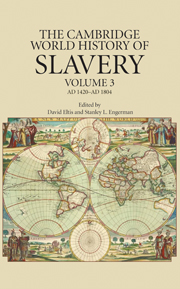Book contents
- Frontmatter
- Contents
- List of Maps, Figures, and Tables
- Contributors
- Series Editors' Introduction
- 1 Dependence, Servility, and Coerced Labor in Time and Space
- PART I SLAVERY IN AFRICA AND ASIA MINOR
- PART II SLAVERY IN ASIA
- PART III SLAVERY AMONG THE INDIGENOUS AMERICANS
- PART IV SLAVERY AND SERFDOM IN EASTERN EUROPE
- PART V SLAVERY IN THE AMERICAS
- PART VI CULTURAL AND DEMOGRAPHIC PATTERNS IN THE AMERICAS
- 19 Demography and Family Structures
- 20 The Concept of Creolization
- 21 Black Women in the Early Americas
- PART VII LEGAL STRUCTURES, ECONOMICS, AND THE MOVEMENT OF COERCED PEOPLES IN THE ATLANTIC WORLD
- PART VIII SLAVERY AND RESISTANCE
- Index
- References
20 - The Concept of Creolization
from PART VI - CULTURAL AND DEMOGRAPHIC PATTERNS IN THE AMERICAS
Published online by Cambridge University Press: 28 September 2011
- Frontmatter
- Contents
- List of Maps, Figures, and Tables
- Contributors
- Series Editors' Introduction
- 1 Dependence, Servility, and Coerced Labor in Time and Space
- PART I SLAVERY IN AFRICA AND ASIA MINOR
- PART II SLAVERY IN ASIA
- PART III SLAVERY AMONG THE INDIGENOUS AMERICANS
- PART IV SLAVERY AND SERFDOM IN EASTERN EUROPE
- PART V SLAVERY IN THE AMERICAS
- PART VI CULTURAL AND DEMOGRAPHIC PATTERNS IN THE AMERICAS
- 19 Demography and Family Structures
- 20 The Concept of Creolization
- 21 Black Women in the Early Americas
- PART VII LEGAL STRUCTURES, ECONOMICS, AND THE MOVEMENT OF COERCED PEOPLES IN THE ATLANTIC WORLD
- PART VIII SLAVERY AND RESISTANCE
- Index
- References
Summary
“New creole, new god”
Jamaican Maroon proverbIn the language of the Saramaka Maroons of Suriname (descendants of rebel slaves), kióo means “young fellow” and carries implications of inventiveness and outrageous behavior – kióos are expected to do things differently from their parents' generation (whether in styles of speech, woodcarving, or dress). During the first couple of decades of Suriname's settlement, in the new language being created by plantation slaves, the equivalent term (krioro) meant “born here” (i.e., not in Africa). We may surmise that today's Saramaka connotations would have been doubly appropriate back then, when these young people – the first American-born generations – were forging new ways of speaking and much else, and teaching these “creolized” ways to their own children.
The concept of creolization – the process by which people, animals, ideas, and institutions with roots in the Old World are born, grow, and prosper in the New – moved from the field of natural history to linguistics, and thence to anthropology and history only in the course of the twentieth century. (The earliest usage in English that refers to cultural as opposed to biological processes seems to date from 1928, when Jonkeer L. C. van Panhuys, in a letter to Melville J. Herskovits, described culture change among the Suriname Maroons as “creolisation.”)
- Type
- Chapter
- Information
- The Cambridge World History of Slavery , pp. 513 - 537Publisher: Cambridge University PressPrint publication year: 2011
References
- 1
- Cited by

